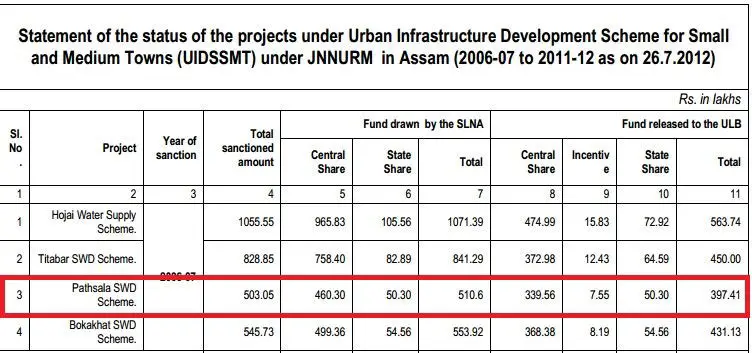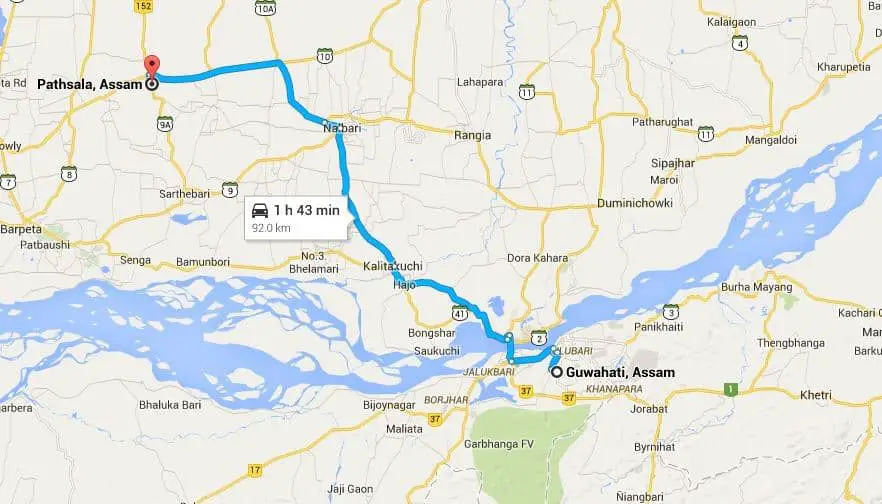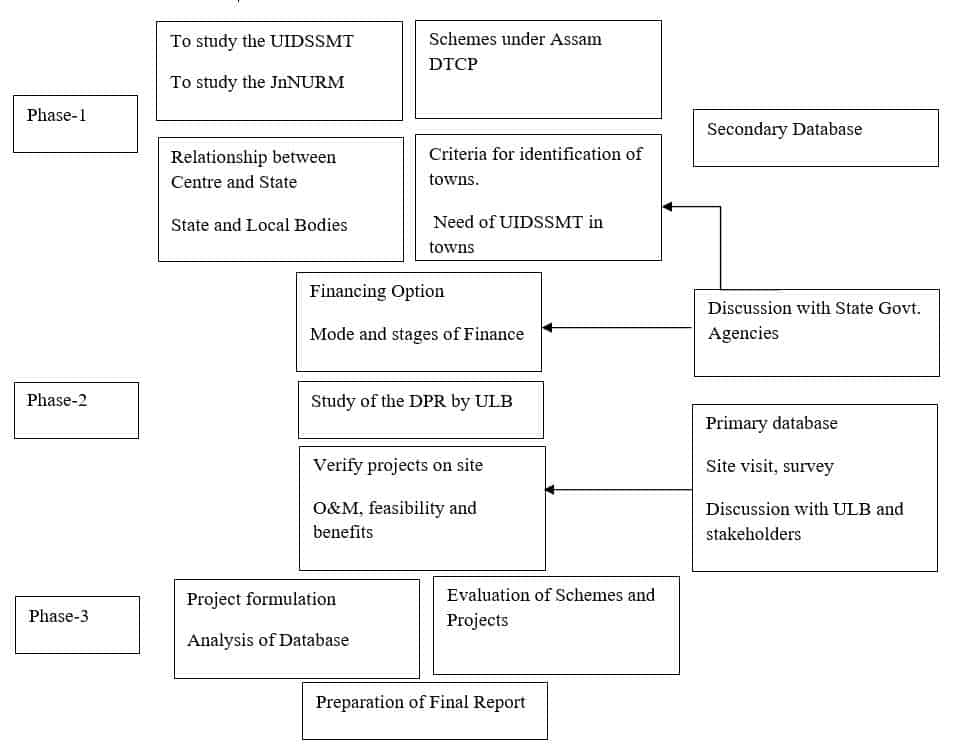Critical Appraisal of Urban Infrastructure Development Scheme for Small and Medium Towns of Assam: a case study of Pathsala Town, Assam
Introduction
Urban Infrastructure Development Scheme for Small and Medium Towns (UIDSSMT) of the Government of India is sponsored by the Government of Assam UIDSSMT aims at improvement in urban infrastructure in towns and cities in a planned manner. UIDSSMT will subsume the existing schemes of Integrated Development of Small and Medium Towns (IDSMT) and accelerated Urban Water Supply Scheme (AUWSP).
Objectives
- Improve infrastructural facilities and help create durable public assets and quality oriented services in cities and towns;
- Enhance public-private partnership in infrastructural development; and
- Promote planned integrated development of towns and cities.
Duration of the scheme: The duration of the scheme announced by the Government of India has begun from 2005-06.
Coverage: The scheme will apply to all cities/towns as per 2001 census, excepting cities/towns covered under the Jawaharlal Nehru National Urban Renewal Mission.
Allocation of funds by GOI is on the basis of the state’s urban population (excluding cities covered under JnNURM) to total urban population in the country (excluding cities covered under JnNURM).
Components
Admissible items
- Urban Renewal i.e., redevelopment of inner (old ) city areas (this would include items like wending of narrow streets, shifting of industrial/commercial establishments from non-conforming (inner-city) to conforming (outer city) areas to reduce congestion, replacement of old and worn-out water pipes by new/higher capacity ones, renewal of sewerage/drainage/solid waste disposal systems etc.
- Sewerage and Solid Waste Management
- Construction and improvement of drains/storm water drains
- Construction/Up gradation of roads, highways/expressways
- Parking lots/spaces on Public Private Partnership basis
- Development of heritage areas
- Prevention and rehabilitation of soil erosion/landslides only in case of special category states where such problems are common and
- Preservation of water bodies.
Inadmissible items
- Power and telecommunication work
- Rolling stock like buses and tram
- Health and educational institution
- Urban Transport (MRTS, LRTS etc
- Wage employment programme and staff component
- Maintenance works
Financing pattern
- Financing Pattern: The sharing of funds would be in the ratio 80:10 between Central Government and State Government and the balance 10% could be raised by the nodal/implementing agencies from the financial institutions.
- Release of Central Assistance: Central assistance (grant) released will go directly to the nodal idencies identified by the state government as Additional Central Assistance. Director of Municipal Administration is designated as State Level Nodal Agency.
- Revolving fund: The grant from Government of India will flow the nodal agency designated by the State Government. The nodal agency will disburse central assistance to Urban Local Bodies or parastatal agencies as the case may be, as soft loan or grant/loan or grant.
- Incentives :After due assessment of status of implementation of activities for which incentives are sought, State Level Sanctioning Committee may sanction additional central grant upto a maximum of 5% to incentivize implementing agencies as indicated below:
- 5% for preparation of Detailed Project Report
- 5% for training and capacity building relating to project/scheme
- 1% for bringing about efficiencies in the projects
- 1% for adoption of innovative approaches and adoption of proven and appropriate technologies.
State Nodal Agency: Directorate of Municipal Administration has been designated as the nodal agency for implementation of this scheme. The Nodal agency is responsible for the following:
- Inviting project proposals from Urban Local Bodies/Para-statal/implementing agencies;
- Techno-economic appraisal of the projects either through in-house expertise or by outside agencies through outsourcing.
- Management of funds received from Central and State Governments; Disbursement of the funds as per the financing pattern given in the guidelines.
- Furnishing of utilization certificates within 12 months of the closure of the financial year and quarterly physical and financial progress reports to the Ministry of Urban Development;
- Maintenance of audited accounts of funds released to ULBs and implementing agencies
- Monitoring of implementation of reforms and infrastructure projects.
Project Appraisal: Urban Local Bodies and implementing agencies including para-statal agencies, will submit detailed project reports to the designated State Level nodal agencies for appraisal. The State Level nodal agency will forward the appraised projects to MoUD, Planning Commission and TCPO so as to reach at least 15 days before the meeting of State Level Sanctioning Committee for enabling representatives to offer their comments/views on the projects in the meeting.
Urban Reforms
The proposed reforms shall broadly fall into two categories:
- Mandatory reforms
- Optional reforms
All the mandatory and optional reforms shall be implemented by the State/Urban Local Body/Para statals within the scheme period.
Monitoring
- Ministry of Urban Development will periodically monitor the scheme through designated officer of the Ministry for Karnataka State.
- State Level Nodal Agency would send quarterly progress report to the Ministry of Urban Development Department through TCPO.
- SLSC would ensure quarterly monitoring of various projects sanctioned under the programme.
- A Monitoring Committee under the Chairmanship of Joint Secretary (Urban Development) in the Ministry of Urban Development would monitor the progress every quarter.
- Secretary, UDD would review progress of the programme twice a year.
- TCPO will be responsible for preparing a status report on the scheme in consultation with MOUD every year (by 31st May). All the mandatory and optional reforms shall be implemented by the State/ULB/Para-statals within the Scheme period.
Training and Capacity Building
The Central and State Governments will make continuous efforts for training and upgrading of the skills of the personnel responsible for the project and the elected representatives. State Government may organise suitable training as well as capacity building programmes through reputed institutions in the field. The same will form part of DPR to be submitted by implementing agency.
Memorandum of Agreement (MoA)
Implementation of all mandatory and at least two optional reforms in each year of the Scheme by cities and towns will be a condition precedent to access central grant under the scheme. All the reforms (mandatory as well as optional) shall be required to be implemented during the scheme period i.e. seven years. The State Governments/State Level Nodal Agencies will execute Memorandum of Agreement (MoA) with Government of India indicating their commitment to implement identified reforms. MoA would spell out specific milestones to be achieved for each item of reform. Signing of MoA will be a necessary condition to access Central Assistance. ULBs/Para-statals will sign MoA with State Level Nodal Agency. The MoA shall be submitted along with Detailed Project Report.
Outcomes of the scheme: On completion of the scheme period of seven years, it is expected that ULBs/Parastatals will achieve the following outcomes:
- Modern and transparent budgeting, accounting, financial management systems designed and adopted for all urban services and governance functions.
- City wide frame work for planning and governance will be established and become operational.
- All urban residents will be able to obtain access to a basic level of urban services.
- Financially self-sustaining agencies for urban governance and service delivery will be established, through reforms to major revenue instruments.
- Local services and governance will be conducted in a manner that is transparent and accountable to citizens.
- E-Governance applications will be introduced in core functions of ULBs/para statals resulting in reduced cost and time of service delivery processes.
Directorate of Town and Country Planning, Assam
The Directorate of Town & Country Planning under Urban Development Department is the SLNA for the two components of JNNURM namely the Integrated Housing and Slum Development Programme (IHSDP) and Urban Infrastructure Development of Small & Medium Towns (UIDSSMT) for small & medium towns in Assam.
So far,30 infrastructure development projects have been sanctioned by Govt. of India for estimated amount of Rs.207.83 crores under UIDSSMT of JNNURM. So far an amount of Rs.123.64 Crores has been released by Govt.of India and State Govt has released Rs.19.45 crores as State matching Share, which are being implemented by concerned ULBs.

Why Pathsala town is being selected for case study?
- The town Pathsala is already in the list of the 30 Small and Medium Towns under the UIDSSMT by Directorate of Town and Country Planning, Assam.
- Rs 397.41 Lakh has been sanctioned for the Solid Waste Disposal Scheme for Pathsala under UIDSSMT by the Govermnet.
- 19 out of 30 towns have been considered for SWD under UIDSSMT where Pathsala is one of those.
About Pathsala
Pathsala is a town and has a town area committee in Barpeta district in the Indian state of Assam.
Demography
As per the Census of 2011, Pathsala had a population of 9652. Males constitute 53% of the population and females 47%. Pathsala has an average literacy rate of 68%, higher than the national average of 59.5%: male literacy is 72%, and female literacy is 61%. In Pathsala, 46% of the population is under 6 years of age. 90% of the population is ethnic Assamese people and they speak Assamese. Remaining 10% of population is Marwari.
Culture
Pathsala is the heritage of theatre in Assam. The mobile theatre groups of Assam have carved a special niche as the mass entertainers in Northeast India. These groups, popularly known as Bhramyaman Theatre arrange shows throughout the Assam and some of its neighbouring states. The groups, having some similarities with the Yatra team of Bengal start a new session from June/July every year. Normally, they start showing their plays from the month August/September and conclude a session in March/April. Every group has its own set of artists and technicians with stages, pandal, other electric and sound equipment, which it carries to the remotest parts of the trouble torn region. In Pathsala, there are three prominent Bhramyaman groups, Namely The Kohinoor Theatre, The Abahan Theatre and The Nataraj Theatre.
The famous Debadashi Dance, different from its South Indian style, has Pathsala as its home. It is said that Bishnu Prasad Rabha, on seeing it performed, ordered that this dance form must be promoted and spread. Dilip Kakati is the person who is currently training his troupe of girls in his attempt to save this art. Manoranjan Das is MLA of Patacharkuchi constituency.
Transportation and Connectivity
- Roadways: NH-31
- Railways: pathsala Railway Station.
- Airways: LGB International Airport, Guwahati

Appraisal approach for Pathsala town
Prepare a critical appraisal report for UIDSSMT of Assam with a case study of Pathsala town by evaluating the functions and implementation of schemes under UIDSSMT for the town.
Objectives to carry out
- To understand the Urban Infrastructure Development Scheme for Small and Medium Towns (UIDSSMT) under JnNURM and study the relevance of the same for Assam.
- To study the existing status of the projects, monitory allocation and implementation process of the various schemes in small and medium towns of Assam.
- To conduct a case study in Pathsala town and evaluate the allocated schemes under Pathsala Nagar Parishad.
- To understand the technical and economic feasibility regarding the planning and implementation process of allocated schemes.
- To prepare a appraisal report and offer possible suggestion to Nagar Parisad as well as Directorate of Town and Country Planning, Assam.
Suggested Methodology

References & Case studies
- Town and Country Planning Organisation website http://tcpomud.gov.in/Divisions/UIDSSMT.html
- Directorate of Town and country Planning Assam website http://tcpassam.gov.in/activities.asp
- Grant Thorton, Appraisal of Jawaharlal Nehru national Urban Renewable Mission, Final report, I Volume http://jnnurm.nic.in/wp-content/uploads/2012/06/Appraisal-of-JnNURM-Final-Report-Volume-I-.pdf
- UIDSSMT utilization certificate, Govermnet of Assam
- International Journal of Scientific & Engineering Research, Volume 4, Issue 12, December-2013, Rinku Manta Jnanashree Borah, and Jayashree Borah, Growth of Small Towns in the Surroundings of Guwahati City, Assam, India
- Case study of Aurangabad district, Maharasthra & Lakhipur Town, Kachar District, Assam
Keywords: UIDSSMT, UIDSSMT appraisal, small towns, medium towns, urbanization, critical appraisal, Assam, UIDSSMT scheme
Author – Hrishiraj Sharma
Year of research – 2016
Kindly contact at [email protected] to request more information about author/ thesis